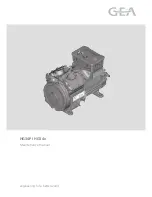
Instructions
2 | AN382129347378en-000101 - 8510306P01AB
© Danfoss | Climate Solutions | 2021.08
1 – Introduction
These instructions pertain to the LLZ scroll
compressors used for refrigeration systems. They
provide necessary information regarding safety
and proper usage of this product.
2 – Handling and storage
•
Handle the compressor with care. Use the
dedicated handles in the packaging. Use the
compressor lifting lug and use appropriate and
safe lifting equipment.
• Store and transport the compressor in an upright
position.
• Store the compressor between -35°C and 70°C /
-31°F and 158°F.
• Don’t expose the compressor and the packaging
to rain or corrosive atmosphere.
3 – Safety measures before assembly
Never use the compressor in a flammable
atmosphere.
• Mount the compressor on a horizontal flat surface
with less than 7° slope.
• Verify that the power supply corresponds to the
compressor motor characteristics (see nameplate).
• When installing a compressor for R452A, R404A/
R507, R448A/R449A, use equipment specifically
reserved for HFC refrigerants which was never
used for CFC or HCFC refrigerants.
•
Use clean and dehydrated refrigeration-grade
copper tubes and silver alloy brazing material.
• Use clean and dehydrated system components.
• The piping connected to the compressor must be
flexible in 3 dimensions to dampen vibrations.
• The compressor must always be mounted with the
rubber grommets supplied with the compressor.
4 – Assembly
•
Slowly release the nitrogen holding charge
through discharge and suction ports.
• Connect the compressor to the system as soon as
possible to avoid oil contamination from ambient
moisture.
• Avoid material entering into the system while
cutting tubes. Never drill holes where burrs
cannot be removed.
• Do not exceed the maximum tightening torque
for rotolock connections
Rotolock connections
Tightening torque
1” Rotolock
80 Nm±10Nm
1” 1/4 Rotolock
90 Nm±10Nm
1” 3/4 Rotolock
110 Nm±10Nm
• Connect the required safety and control devices.
When the schrader port, if any, is used for this,
remove the internal valve.
5 – Leak detection
Never pressurize the circuit with oxygen or dry
air. This could cause fire or explosion.
• Do not use leak detection dye.
• Perform a leak detection test on the complete
system.
• The low side test pressure must not exceed 31 bar
/450 psi.
• When a leak is discovered, repair the leak and
repeat the leak detection.
6 – Vacuum dehydration
• Never use the compressor to evacuate the system.
• Connect a vacuum pump to both the LP & HP
sides.
•
Pull down the system under a vacuum of
500 µm Hg (0.67 mbar) / 0.02 inch Hg absolute.
• Do not use a megohmmeter nor apply power to
the compressor while it is under vacuum as this
may cause internal damage.
7 – Electrical connections
• Switch off and isolate the main power supply.
• All electrical components must be selected as per
local standards and compressor requirements.
• Refer to page 1 for electrical connections details.
For three phase applications, the terminals are
labeled T1, T2, and T3.
• Danfoss scroll compressors will only compress gas
while rotating counter-clockwise (when viewed
from the compressor top). Three-phase motors,
however, will start and run in either direction,
depending on the phase angles of the supplied
power. Care must be taken during installation
to ensure that the compressor operates in the
correct direction.
• Use ø 4.8 mm / #10 - 32 screws and ¼” ring
terminals for the power connection with ring
connect screw terminal (C type). Fasten with 3 Nm
torque.
•
Use a self tapping screw to connect the
compressor to earth.
8 – Filling the system
• Keep the compressor switched off.
• Keep the refrigerant charge below the indicated
charge limits if possible. Above this limit; protect
the compressor against liquid flood-back with a
pump-down cycle or suction line accumulator.
• Never leave the filling cylinder connected to the
circuit.
Compressor models
Refrigerant charge limit
LLZ013-015-018
4.5 kg / 10 lb
LLZ024-034
7.2 kg / 16 lb
M
DGT
HPs
180 s
TH
LP
CONTROL CIRCUIT
F1
F1
KM
KM
KM
KA
KA
A1
A2
A3
KA
KA
KS
KS
KS
L1
L3
L2
Q1
T1
T3
T2
LLSV
KS
PM
Three phase (Wiring diagram with pump-down cycle)






















